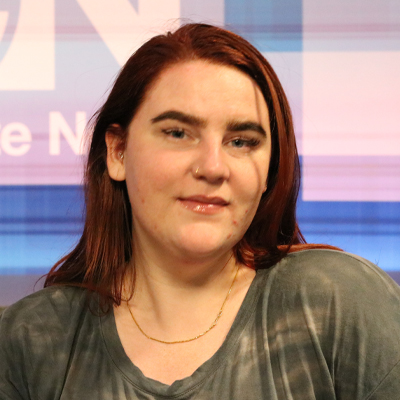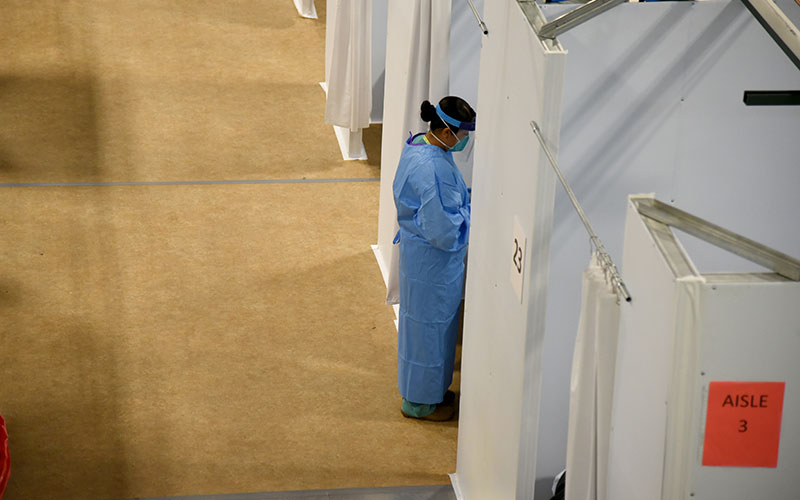
Masks are imperative to prevent the spread of COVID-19 and its variants, Navajo public health officials say. (Photo by grandriver/Getty Images)
PHOENIX – Cases of the delta variant are rising quickly in the U.S., but Navajo officials say they made the right decision earlier this month to reopen parts of the nation at 50% capacity.
The Centers for Disease Control and Prevention now estimates the fast-spreading delta variant of the coronavirus that causes COVID-19 is responsible for more than 83% of cases in the U.S, a sharp uptick from the 50% reported the first week of July.
In a statement Sunday, the Navajo Department of Health reported 30 new COVID-19 cases over the weekend. Two new deaths were reported Saturday, bringing the total up to 1,366. There were six new cases reported as of Monday.
Despite the new cases, Navajo President Jonathan Nez and health officials are confident about gradually opening the reservation to visitors.
“We’re not out of the woods yet,” Nez told Cronkite News recently. “We’re seeing cases rise all around us.”
That includes Arizona, where 384 cases of the delta variant have been sequenced since January, according to TGen and the Department of Health Services.
The delta variant “is here,” Nez said, “the variant is getting detected, but we don’t see an increase in hospital cases here on the Navajo Nation.”
On July 7, leaders reopened some public spaces, including most restaurants and parks, such as Canyon de Chelly and Monument Valley, at 50% capacity. Health officials also declared “yellow status,” which allows schools and youth programs to operate at half capacity. Masks are still required when visiting sites in the nation.
More than half the eligible Navajo population is vaccinated, Nez said. Of those living on the reservation, the vaccination rate is about 70%, he said.
“Based on the public health experts that surround me … the support was unanimous to reopen the nation,” Nez said.
Mutations like the delta variant are the nation’s biggest concern – the reservation once had the highest per-capita infection rate in the U.S. – and can only be checked by immunization, he said. The goal is to get 90% vaccinated.
“We need to stop the changing of, the mutation of COVID-19. In order to do that, we have to get to community immunity,” he said.
Dr. Jill Jim, executive director of the Navajo Department of Health, and other public health officials emphasized the importance of continued safety precautions, including masks.
“We still have daily curfews, we still have our mask wearing that’s required,” Jim said. “We are still implementing more safety measures and community mitigation strategies compared to any of the states.”
In addition to strict safety measures, which include hand washing and social distancing, the Navajo Department of Health leads the vaccination campaign, including a text messaging alert system and weekly radio forums.
Contact tracers, who get in touch with exposed people within 24 hours, are the tribe’s most effective tool to isolate new cases of COVID-19 and prevent transmission, Jim said.
“They’re able to get people isolated in quarantine and give them the proper advice,” she said.
Jim said health officials are thankful cases are low right now. At some points since the pandemic began in March 2020, the Navajo Nation has had to bring in virtual contact tracers to areas where contact tracers aren’t available.
Nez said morale is high surrounding the eased restrictions. Days before restrictions were relaxed, people were allowed to gather in small groups to celebrate the Fourth of July.
“Hearing the Navajo people at these events having a good time, the kids, the children, you know, excited and shouting, I think that was the turning point for us as leaders,” he said, and reflective of tribal leaders’ hard work pushing back against the virus.
Jim stressed that such celebrations will be conducted in a controlled manner.
“Those are just some things that are certainly missed, but we’re not here to throw off our masks,” she said.
The opportunity to gather signified healing, Jim said.
“We were one of the highest hit,” she said, “so I think there’s a lot of recovery that’s going to happen, and it’s going to require these types of activities to bring us back together as human beings to celebrate life.”
She also attributed the success of the nation’s response to COVID-19 to tribal leadership’s belief in science and in their strong decision making.
“It doesn’t just take one person, it takes the entire Navajo Nation,” she said.
Nez said the people have remained resilient in the face of this silent killer.
“We overcame those difficult times, and we will overcome COVID-19 together,” he said.


